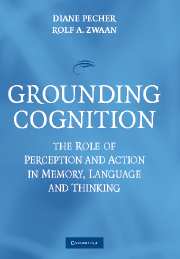Book contents
- Frontmatter
- Contents
- List of Contributors
- 1 Introduction to Grounding Cognition: The Role of Perception and Action in Memory, Language, and Thinking
- 2 Object Concepts and Action
- 3 Constraints on Spatial Language Comprehension: Function and Geometry
- 4 Embodiment in Metaphorical Imagination
- 5 Passionate Thoughts: The Emotional Embodiment of Moral Concepts
- 6 Grounding Language in Bodily States: The Case for Emotion
- 7 Situating Abstract Concepts
- 8 Dynamicity, Fictivity, and Scanning: The Imaginative Basis of Logic and Linguistic Meaning
- 9 The Emergence of Grammar from Perspective
- 10 Embodied Sentence Comprehension
- 11 On the Perceptual-Motor and Image-Schematic Infrastructure of Language
- 12 Connecting Concepts to Each Other and the World
- Author Index
- Subject Index
- References
6 - Grounding Language in Bodily States: The Case for Emotion
Published online by Cambridge University Press: 22 July 2009
- Frontmatter
- Contents
- List of Contributors
- 1 Introduction to Grounding Cognition: The Role of Perception and Action in Memory, Language, and Thinking
- 2 Object Concepts and Action
- 3 Constraints on Spatial Language Comprehension: Function and Geometry
- 4 Embodiment in Metaphorical Imagination
- 5 Passionate Thoughts: The Emotional Embodiment of Moral Concepts
- 6 Grounding Language in Bodily States: The Case for Emotion
- 7 Situating Abstract Concepts
- 8 Dynamicity, Fictivity, and Scanning: The Imaginative Basis of Logic and Linguistic Meaning
- 9 The Emergence of Grammar from Perspective
- 10 Embodied Sentence Comprehension
- 11 On the Perceptual-Motor and Image-Schematic Infrastructure of Language
- 12 Connecting Concepts to Each Other and the World
- Author Index
- Subject Index
- References
Summary
It has become increasingly clear over the past few years that the symbols used by language become meaningful through grounding. For example, Glenberg and Kaschak (2002) demonstrated that some linguistic constructions are grounded in literal action, and Pecher, Zeelenberg, and Barsalou (2003), as well as Stanfield and Zwaan (2001), showed how language is grounded in perceptual and imaginal states, respectively. In this chapter, we report initial results demonstrating how language may also be grounded in the bodily states that comprise emotions. We begin by discussing the logical and theoretical reasons for supposing that language is grounded in bodily states, and then we move to a brief review of the recent work demonstrating grounding in action and perceptual states. This introductory material is followed by the report of two experiments consistent with the claim that language about emotional states is more completely understood when those states are literally embodied during comprehension.
WHY LANGUAGE MUST BE GROUNDED OUTSIDE THE LINGUISTIC SYSTEM
To ask how a symbol is grounded is to ask how it becomes meaningful by mapping it onto something else that is already meaningful. One hypothesis is that linguistic symbols (e.g., words and syntactic constructions) become meaningful only when they are mapped to nonlinguistic experiences such as actions and perceptions. A second hypothesis is that linguistic symbols can be grounded in other linguistic symbols. For example, words are often defined in terms of other words: That is exactly how most dictionaries work.
- Type
- Chapter
- Information
- Grounding CognitionThe Role of Perception and Action in Memory, Language, and Thinking, pp. 115 - 128Publisher: Cambridge University PressPrint publication year: 2005
References
- 48
- Cited by



